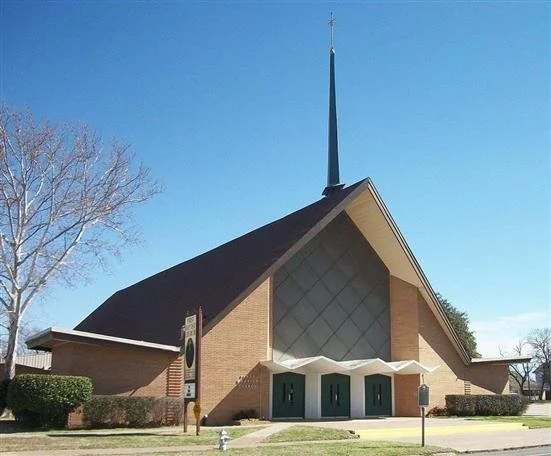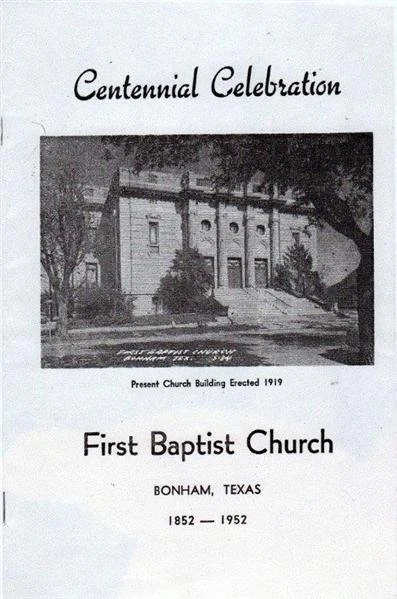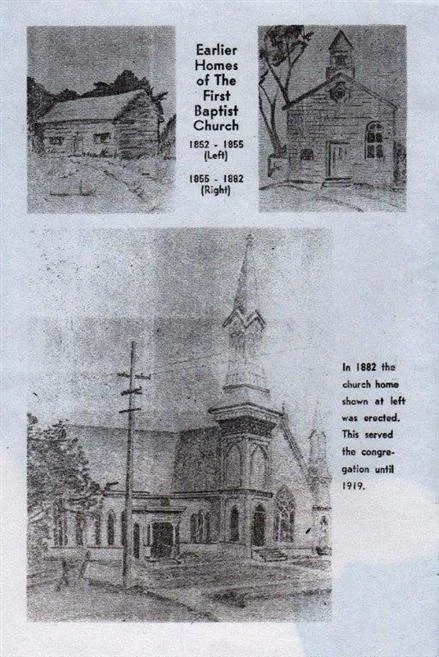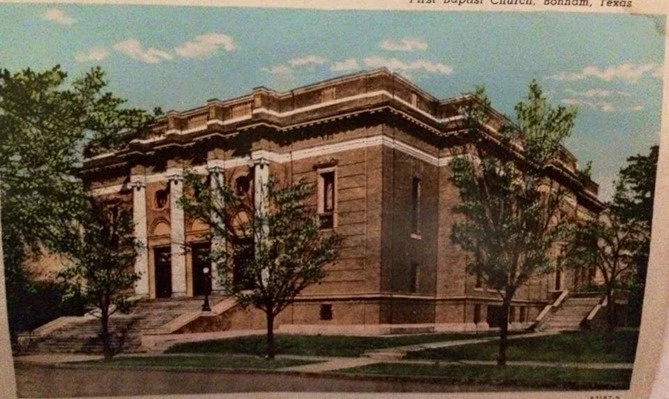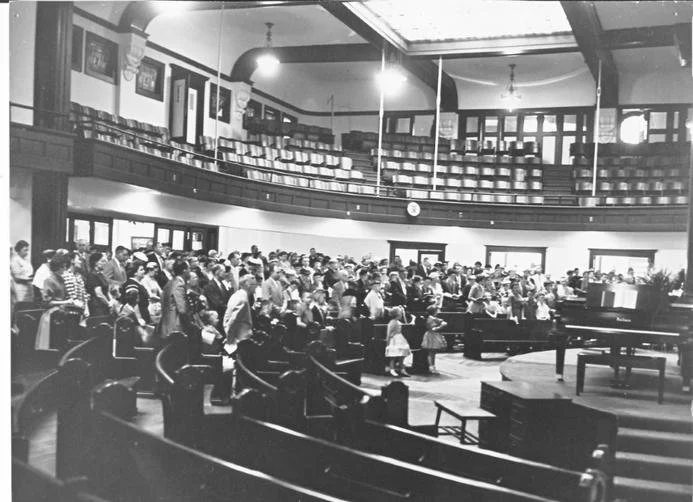First Baptist Church, Bonham
Marker Text:
Organized November, 1852, under the Rev. J. R. Briscoe with six charter members. The first log church on this site doubled as the school. Cost of this lot - then outside city limits - was $50. Indian trail lay northeast.
In 1855 a new frame church was built; baptisms were held in Saunder's pool on West 7th. Other denominations were also allowed to worship here.
New churches were built in 1882 and 1921, the latter being dedicated by George W. Truett, noted evangelist. The present church was dedicated 1959 under the Rev. Jack M. Carson, pastor.
Location: Center and 8th St., Bonham
The History of the First Baptist Church
Phase I - 1852-1882
Sixteen years following the founding of Bonham and seven years after the annexation of Texas into the United States, the First Baptist Church of Bonham was organized. Rev. J. R. Briscoe, a pioneer Baptist preacher led in the organization of this church in early November, 1852. Six charter members constituted the membership of the church which came into being in the early Masonic Hall. These six Charter members were; S. D. Rainey, Mrs. Mary Rainey, Mrs. Martha Gilbert, Miss Lizzie Russell, David Coward, and B. F. Fuller. This new church called Brother Briscoe as its pastor at an annual salary of $125.
Soon after the organization of the church the small congregation moved to a log building which stood on the same lot where all the succeeding buildings have been built. The first church building program was in 1855 when a frame church was erected at a cost of $3,000. This church building served until 1882 when a larger structure was erected, and the old building was converted into a parsonage.
Though this building was erected by Bonham Baptists, it served several other congregations in the town. The Episcopal church of Bonham was organized in this building.
Due to the consistant growth of the First Baptist Church, it became evident that another building would be necessary, and with its erection the pioneer phase of Baptist work in Bonham came to a close in 1882 with the erection of the church building which served the congregation until 1919.
Phase II - 1882 - 1921
These years were marked by steady growth in church membership, organization of missionary zeal. Each pastor contributed invaluable spiritual leadership through his individual gift. The Sunday School, which had its beginning at the founding of the church, now reached new heights in numbers and organization. The organization for special missionary work among the women, which had begun in 1881 under the name of the "Ladies' Aid and Missionary Society,", was reorganized in 1901 under the present name of the "Woman's Missionary Union." Dr. D. G. Whittinghill, pastor in 1901, resigned to go to Rome, Italy as a missionary. Later in the same year, Miss Mary D. Willeford, a teacher in the Bonham Public Schools and an active member of the First Baptist Church answered the call for missionary work in China, where she served for thirty-five years. A blessing of inspiration and challenge came upon the home church through these two missionaries. The first young people's organization, under the name of the "Baptist Young People's Union" had its beginning in 1903. Yearly revival meetings kept the spirit of evangelism foremost in the church program. Among the able evangelists of this church period, were W. E. Penn, M. E. Dodd, George Truett, F. M. McConnell, W. Y. Pond, Sid Williams, T. T. Martin, and James Leavell. In 1912, the church parsonage was moved from the church lot to a new location on East Ninth street, one block from the church. By the year 1915, the church building was no longer adequate for further growth and development. Brother Cowan led out in a building crusade. His enthusiasm and high spiritual aspirations for he church helped greatly toward the realization of the building during the next pastorate. Rev. Ernest Quick became pastor in 1917 and immediately gave of his ability and strength to further the building program. The result was an outstanding example of victory under the leadership of the Lord through the sacrificial efforts of the members. Even in the face of unusual difficulties at that time, the beginning of World War I, the building was completed and freed of all indebtedness by the date of dedication, April 24, 1921. Dr. George W. Truett preached the dedicatory sermon.
Phase III - 1921-1952
Now that the new building was realized, the aim of the pastor and the members was expressed in the text chosen by the pastor for his first sermon, "Where there is no vision, the people perish." The building of massive structure and spacious arrangement seemed entirely too large in the eyes of many, but those who could visualize the future expansion which would come in every department of the church, could foresee a day when the spacious building would no longer be adequate.
A vision of spiritual growth led to Bible Conferences conducted by such able leaders as Dr. W. B. Riley, Dr. J. B. Lawrence, Dr. T. T. Shields, Dr. A.H. Carter and others. The result of spiritual revival and greater appreciation for Bible study has been a continuous inspiration until the present time. Also, evangelism has been magnified during each pastorate. Periodic revival meetings have been led by outstanding evangelists and pastors.
The remaining pastorate of Rev. Ernest Quick and the pastorates of Dr. F. M. McConnell, Rev. W. H. Horton, Rev. R. M. Jennings, Rev. S. R. Smith, Rev. J. I. Gregory, Rev. John W. Salzman, and the present pastor, Rev. Darold Morgan have been used mightily of the Lord in advancing spiritual and material causes. The church budget has been increased each year to take care of the growing need for home and foreign contributions. The Sunday School has been reorganized from time to time to provide for the increase in enrollment, which has grown from 600 to the present number of 1000. The building is now inadequate for further growth and organization. Also, the Training Union, the Woman's Missionary Union and the Brotherhood have grown into great strongholds of training and service for members of all ages.
In August 1948, the church parsonage was exchanged for another residence two blocks farther on the same street.
In 1950, two adjoining residence lots east of the church were providentially available and were bought by the church. One building was sold from the lot and the other was retained for additional Sunday School space. The vacant lot is being used for parking, but plans are underway to erect on it a much-needed education building.
In December 1951, the Bonham church adopted a medical missionary, Dr. August Lovegren as a special charge of the church in missionary contribution. The Lovegrens are in Lebanon preparatory to service in Transjordan. Appropriations in the church budget for missions at home and abroad have been larger during the past two years than in any previous years.
The Centennial year is closing with a resident membership of 1150, not only the greatest in numbers in the history of the church but greatest in organization and worldwide program. This realization is not felt by the pastor or the members in a spirit of boastfulness, but rather in a spirit of humble gratitude to God for His manifold blessings. This together with a deep appreciation for the noble heritage we possess through the faith and work of all who have had a part in these hundred years of church history, makes our forward look a challenge to greater privileges and opportunities as well as responsibilities.
A larger version of this is on Flickr.
